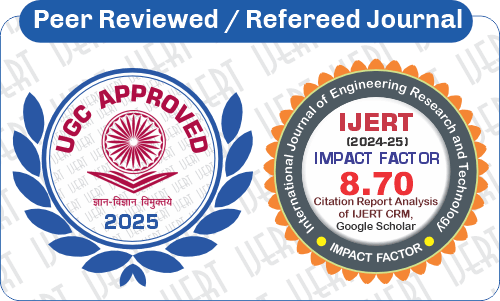 DOI : 10.17577/IJERTV7IS090002
DOI : 10.17577/IJERTV7IS090002
- Open Access

- Total Downloads : 0
- Authors : Tauseef Bashir , Manjit Kour
- Paper ID : IJERTV7IS090002
- Volume & Issue : Volume 07, Issue 09 (September – 2018)
- Published (First Online): 05-01-2019
- ISSN (Online) : 2278-0181
- Publisher Name : IJERT
- License:
 This work is licensed under a Creative Commons Attribution 4.0 International License
This work is licensed under a Creative Commons Attribution 4.0 International License
Effect of Silt Content on the Strength Property of Concrete A Case Study
Effect of Silt Content on the Strength Property of Concrete A Case Study
1. Tauseef Bashir,
Student,
Department of structural engineering, Indo Global Group of Colleges Mohali, Punjab 140109
2 Manjit Kour Science
Assistant Professor, Department of Structural Engineering, Indo Global Group of Colleges Mohali,
Punjab 140109
Abstract – This project is robust with the effects of different quantities of silt content present in fine aggregates on the strength of concrete. The 3 days, 7 days, & 28 days compressive strength of concrete is checked. 36 samples were tested. For different tests such as compressive strength, split tensile strength, flexural strength on different shaped samples (cube, cylinder, & beam). Each 9 samples casted with different fine aggregates found in the river Jehlum at different locations namely, Qamarwari, Pampore, and Lasjan. Each sample is casted with design mix of M30 ratio.
INTRODUCTION
-
: SILT:
Silt consists of small particles or grains of soil and minerals that are easily carried and deposited by water. Each particle is smaller than a grain of sand but larger than a clay particle. When heavy rains pound the soil some of these fine granular particles are carried by the runoff water as silt. Silt carried by water runoff is deposited in lowlands, rivers or ponds as sediment. The environmental impact of silt is enormous, as once it settles into a river or lowland it provides valuable nutrients for plants and insects in the sediment it creates.
Silt carried down the Nile River, for example, created an oasis of rich, fertile soil for the ancient Egyptians. Silt is carried down the Mississippi and other rivers to the ocean where it also provides a rich habitat for plants and fish. But silt can also be a source of problems by clogging pipes and drains. When too much silt is dumped into waterways or rivers, it can become a pollutant known as siltation. This can cause a number of environmental problems, including killing fish by clogging their gills, and by reducing the water's dissolved oxygen level
-
: Properties and characteristics of Silt:
Silt is granular material of a size between sand and clay, whose mineral origin is quartz and feldspar. Silt may occur as a soil (often mixed with sand or clay) or as sediment mixed in suspension with water (also known as a suspended load) and soil in a body of water such as a river. It may also exist as soil deposited at the bottom of a water body, like mudflows from landslides. Silt has a
moderate specific area with a typically non-sticky, plastic feel. Silt usually has a floury feel when dry, and a slippery feel when wet. Silt can be visually observed with a hand lens.
Silt particles range between 0.0039 and 0.0625 mm, larger than clay but smaller than sand particles. ISO 14688 grades silts between 0.002 mm and 0.063 mm. In actuality, silt is chemically distinct from clay, and unlike clay, grains of silt are approximately the same size in all dimensions; furthermore, their size ranges overlap. Clays are formed from thin plate-shaped particles held together by electrostatic forces, so present cohesion. According to the U.S. Department of Agriculture Soil Texture Classification system, the sand-silt distinction is made at the
0.05 mm particle size. The USDA system has been adopted by the Food and Agriculture Organization (FAO). In the Unified Soil Classification System (USCS) and the AASHTO Soil Classification system, the sand-silt distinction is made at the 0.075 mm particle size (i.e., material passing the #200 sieve). Silts and clays are distinguished mechanically by their plasticity
-
Effects of silt on hardened concrete:
Effect of silt fines on the durability properties of concrete. Silt fines are fine aggregate particles smaller than the 75 m (No. 200) sieve. … The compressive strength, however, when silt fine content is small than 5%, increases only 1 MPa. But decreases from 3 MPa to 5 MPa when the silt content increases from 7% to 9%…were cast and tested in this study. Moreover, chloride transport tests were conducted to investigate the properties of concrete. Test results indicate a decrease in durability when the ratio of silt content to fine aggregate exceeds 5%. The compressive strength, however, when silt fine content is small than 5%, increases only 1 MPa. But decreases from 3 MPa to 5 MPa when the silt content increases from 7% to 9%. These results could serve as a reference in concrete production as well as quality control of fine aggregate containing a large amount of silt fines.
-
SOURCE OF MATERIALS AND TEST DATA
S.No
Name of Materials
Source
Specific Gravity
Water Absorption (%)
Silt Content(%)
1
Cement OPC 43 Brand TCI
3.15
–
–
2
Coarse Aggregates (20.mm)
QAMARWARI
2.84
–
–
3
Fine Aggregates
QAMARWARI, LASJAN, PAMPORE
2.64
2.64
2.64
7.5
4.17
2.5
6.65
4.65
4.8
4
Water
1
–
–
–
-
OBSERVATION AND CALCULATION OF SILT CONTENT AS PER IS 383 FOR QAMARWARI SAMPLE
Description
Sample Numbers
Sample-1
Sample-2
Sample-2
Volume of sample, V1 (ml)
75
75
75
Volume of silt after 3 hours, V2(ml)
5
6
4
% silt by volume =(V2/V1)*100
6.67
8
5.3
Average of above three values =6.65%
-
OBSERVATION AND CALCULATION OF SILT CONTENT FOR LASJAN SAMPLE AS PER IS 383
Description
Sample Numbers
Sample-1
Sample-2
Sample-2
Volume of sample, V1 (ml)
82
82
82
Volume of silt after 3 hours, V2(ml)
3
5
4
% silt by volume =(V2/V1)*100
3.4
5.8
4.8
Average of above three values =4.65%
-
OBSERVATION AND CALCULATION OF SILT CONTENT FOR PAMPORE SAMPLE AS PER IS 383
Description
Sample Numbers
Sample-1
Sample-2
Sample-2
Volume of sample, V1 (ml)
82
82
82
Volume of silt after 3 hours, V2(ml)
5
4
3
% silt by volume =(V2/V1)*100
6.0
4.8
3.6
Average of above three values =4.8%
-
Details of Lasjan Sample
-
-
SAMPLE DETAILS
Ingredients: Qantity
Cement 23Kg
Coarse Aggregates 74Kg
Fine Aggregates 35Kg
Water 9Kg
Zone of Sand IV
Silt Content 4.65%
Water Content in Sand 4.17%
-
Details of Pampore Sample
Ingredients: Quantity
Cement 22.97Kg
Coarse Aggregates 70Kg
Fine Aggregates 33.21Kg
Water 9.45Kg
Zone of Sand IV
Silt Content 4.8%
Water Content in Sand 4.8%
-
Details of Qamarwari Sample
Ingredients: Quantity
Cement 22.97Kg
Coarse Aggregates 70Kg
Fine Aggregates 33.21Kg
Water 7.45Kg
Zone of Sand IV
Silt Content 6.65%
Water Content in Sand 7.5%
-
Tests Performed
-
Compressive strength test
-
Split tensile test
-
Flexural strength test
-
SPECIMEN USED, RESULTS AND DISCUSSION
Compressive strength test
-
cubes of 15 cm size Mix. M30 Split tensile test
Concrete cylinder 15 cm diameter & 30cm long Flexural strength test
Beam mould of size 15 x 15x 70 cm (when size of aggregate is less than 38 mm)
8. RESULTS OF LASJAN SAMPLE
The compressive strength, split tensile strength, flexural strength test of concrete with silt content of 4.65% is shown in this table of different specimen.
Test date
CUBE(COMPRESSIVE STENGTH TEST) (N/ mm2 )
CYLINDER(SPLIT TENSILE TEST) (N/ mm2 )
BEAM(FLEXURAL STRENGTH TEST) (N/ mm2 )
3-days
435
110
8
7-days
480
160
13
28-days
722
185
15
The 3-days, 7days and 28 days compressive strength of lasjan sample is shown in the graph below:-
Cube Compressive Strength of Lasjan Sample
Compressive Strength (N/mm2)
Compressive Strength Lasjan(N/mm2)
800
700
600
500
400
300
200
100
0
3-days 7-days 28-days
Days
Compressive Strength
Lasjan
The 3-days, 7days and 28 days Split Tensile Strength of lasjan sample is shown in the graph below:-
Cylinder Split Tensile Strength of Lasjan Sample
CYLINDER(SPLIT TENSILE TEST) (N/ mm2 )
Split Tensile Strength(N/mm
200
180
160
140
120
100
80
60
40
20
0
3-days 7-days 28-days
Days
CYLINDER(SPLIT TENSILE TEST) (N/ mm2 )
The 3-days, 7days and 28 days Flexural strength of lasjan sample is shown in the graph below:-
Beam Flexural Strength of Lasjan Sample
BEAM(FLEXURAL STRENGTH TEST) (N/
mm2 )
16
Flexural Strength
14
12
10
8
6
4
2
0
3-days 7-days 28-days
Days
BEAM(FLEXURAL STRENGTH TEST) (N/
mm2 )
-
DETAILS OF PAMPORE SAMPLE
The compressive strength, split tensile strength, flexural strength test of concrete with silt content of 4.80% is shown in this table of different specimen.
Test date
CUBE(COMPRESSIVE STENGTH TEST) (N/ mm2 )
CYLINDER(SPLIT TENSILE TEST) (N/ mm2 )
BEAM(FLEXURAL STRENGTH TEST) (N/
mm2 )
3-days
420
80
7
7-days
472
120
12
28-days
705
150
14
The 3-days, 7days and 28 days compressive strength of pampore sample is shown in the graph below:-
Cube Compressive Strength of Pampore Sample
Compressive Strength(N/mm
Cube Compressive Strength Pampore(N/mm2)
800
700
600
500
400
300
200
100
0
3-days 7-days 28-days
Days
Cube Compressive Strength Pampore
The 3-days, 7days and 28 days Split Tensile Strength of pampore sample is shown in the graph below:-
Cylinder Split Tensile Test of Pampore Sample
Cylindrical Split Tensile Test Pampore(N/mm2)
160
Tensile Strength(N/mm
140
120
100
80
60
40
20
0
-
days 7-days 28-days
Days
Cylindrical Split Tensile Test Pampore
The 3-days, 7days and 28 days Flexural strength of Pampore sample is shown in the graph below:-
Beam Flexural Strength of Pampore Sample
BEAM(FLEXURAL STRENGTH TEST)
(N/ mm2 )
16
14
Flexural Strength
12
10
8
6
4
2
0
3-days 7-days
Days
BEAM(FLEXURAL STRENGTH TEST) (N/
mm2 )
From above results it is observed that sand from pampore with silt content 4.80 %, compressive strength, split tensile strength, and flexural strength is increased as days of curing increased. If results are compared with sand from Lasjan with silt content (4.65%), it is observed that all strength is decreasing as slit content is increased.
-
-
RESULTS OF QAMARWARI SAMPLE
-
-
-
The compressive strength, split tensile strength, flexural strength test of concrete with silt content of 6.65% is shown in this table of different specimen.
|
Test date |
CUBE(COMPRESSIVE STENGTH TEST) (N/ mm2 ) |
CYLINDER(SPLIT TENSILE TEST)( N/ mm2 ) |
BEAM(FLEXURAL STRENGTH TEST)( N/ mm2 ) |
|
3-days |
320 |
70 |
6 |
|
7-days |
450 |
110 |
10 |
|
28-days |
630 |
130 |
13 |
The 3-days, 7days and 28 days compressive strength of Qamarwari sample is shown in the graph below:-
400
300
200
Cube Compressive Strength
Qamarwari
100
0
Compressive Strength (N/mm2)
Cube compressive Strength of Qamarwari Sample
700
600
500
Cube Compressive Strength
Qamarwari(N/mm2)
3-days
7-days
28-days
Days
The 3-days, 7days and 28 days Split Tensile Strength of qamarwari sample is shown in the graph below:-
Cylinder Split Tensile Test of Qamarwari Sample
CYLINDER(SPLIT TENSILE TEST)( N/ mm2 )
Tensile Strength (N/mm2)
200
180
160
140
120
100
80
60
40
20
0
3-days 7-days 28-days
Days
CYLINDER(SPLIT TENSILE TEST)( N/ mm2 )
The 3-days, 7days and 28 days Flexural strength of Qamarwari sample is shown in the graph below:-
Beam Flexural Strength of Qamarwari Sample
BEAM(FLEXURAL STRENGTH TEST)(
Flexural Strength(N/mm2)
N/ mm2 )
14
12
10
8
6 BEAM(FLEXURAL
4 STRENGTH TEST)( N/
2 mm2 )
0
3-days 7-days 28-days
Days
From above results it is observed that sand from pampore, Lasjan and qamarwari with silt content 4.80 %, 4.65% and 6.65% compressive strength, split tensile strength, and flexural strength is increased as days of curing increased. If results are compared with sand from Lasjan with silt content (4.65%), it is observed that all strength is decreasing as slit content is increased.
-
At the end, all the strengths are compared with each other .
In below graph comparison of compressive strength of sand from different location having different percentage of silt content are shown.
Compressive Strength of Three samples Take at Different Locations
800
700
Compressive Strength(N/mm2)
600
500
400
300
200
100
compressive strength of lasjan sample
compressive of Pampore sample
compressive strength of Qamarwari sample
0
3-days 7-days 28-days
No. of Days(curing)
In Below split tensile strength of all the samples taken from three different locations are compared with each other having different percentage of silt content.
Split Tensile Strength OF Three Samples Taken From Different Locations
200
Split Tensile Strength (N/mm2)
180
160
140
120
100
80
60
40
20
0
3-days 7-days 28-days
No. of Days(Curing)
Split Tensile Strength of Lasjan Sample
Split Tensile Strength of Pampore Sample
Split Tensile Strength of Qamarwari sample
In below Bar Chart flexural strength of all the samples taken from three different locations are compared with each other having different percentage of silt content .
Flexural Strength of Three Samples Taken From Different Locations
16
14
12
Flexural Strength (N/mm2)
10 Flexural Strength of Lasjan
sample
8 Flexural Strength of Pampore
6 Sample
Flexural Strength of Qamarwari
4 sample
2
0
3-days 7-days 28-days
No. of Days(Curing)
From above graphs, it is observed that all types of strengths are decreases as the silt content is increases.
CONCLUSION:
Based on the experimental investigations, the following conclusions were drawn.
-
The control mix for M30 grade with the varying quantity of silt content by 6.65%, 4.65%, & 4.80% were designed.
-
It is concluded that with the increase in 0.15% of silt content in fine aggregates, the compressive strength of concrete mixes decreases by 0.15%,0.08%,and 0.17% after 3,7 and 28 days respectively comparing Lasjan and Pampore samples.
-
It is concluded that with the increase in 1.85% of silt content in fine aggregates, the compressive strength of concrete mixes decreases by 1%, 0.22%, and 0.75% after 3,
-
and 28 days respectively comparing pampore and qamarwari samples.
-
-
) It is concluded that with the increase in 2% of silt content in fine aggregates, the compressive strength of concrete mixes decreases by 1.15%,0.30%,and 0.92% after 3,7 and 28 days respectively comparing Lasjan and Qamarwari samples.
-
) It is concluded that with the increase in 0.15% of silt content in fine aggregates, the Split Tensile strength of concrete mixes decreases by 0.3%,0.40%,and 0.35% after 3,7 and 28 days respectively comparing Lasjan and Pampore samples.
-
It is concluded that with the increase in 1.85% of silt content in fine aggregates, the Split Tensile strength of concrete mixes decreases by 0.1%, 0.1%, and 0.2% after 3,
7 and 28 days respectively comparing qamarwari and Pampore samples.
-
) It is concluded that with the increase in 2% of silt content in fine aggregates, the compressive strength of concrete mixes decreases by 1.4%,0.5%,and 0.55% after 3,7 and 28 days respectively comparing Lasjan and Qamarwari samples.
-
) It is concluded that with the increase in 0.15% of silt content in fine aggregates, the flexural strength of concrete mixes decreases by 0.01%,0.01%,and 0.01% after 3,7 and
28 days respectively comparing Lasjan and pampore samples.
-
) It is concluded that with the increase in 1,85% of silt content in fine aggregates, the compressive strength of concrete mixes decreases by 0.01%,0.02%,and 0.01% after 3,7 and 28 days respectively comparing pampore and Qamarwari samples.
-
) It is concluded that with the increase in 2% of silt content in fine aggregates, the flexural strength of concrete mixes decreases by 1.02%,0.03%,and 0.02% after 3,7 and
28 days respectively comparing Lasjan and Qamarwari samples.
REFRENCES:
[1] ASTM C33, Standard Specification for Concrete Aggregates, American Society for Testing and Materials,U.S.A. (2003).
[2] British Standard 882 (1992), Specification for Aggregates from Natural Sources for Concrete. [3] British Standard (BSEN 1008:2002) (2002), Mixing Water for Concrete: Specification for Common Cements. [4] British Standard (BSEN 197-1:2000) (2004), Composition, Specifications and Conformity Criteria for Common Cements. [5] CNS 1240, Concrete Aggregates, National Standards of the Republic of China, Taiwan, R.O.C. (1994).] Chen, C. Y., Study on the Characteristics of River Sands from Nan-Au River, Master Degree Thesis, National Taiwan Ocean University, Keelung, Taiwan, R.O.C. (2001). [6] Department of Transportation, Report No. 0092- 00-07, WI,U.S.A. (2002).
[7] Donza, H., Cabrera, O. and Irassar, E. F., High- Strength Concrete with Different Fine Aggregate, Cement and Concrete Research, Vol. 32, No. 11, pp. 1755_1761 (2002).doi: 10.1016/S0008-8846(02) 00860-8
[8] Feleko_lu, B. and Sarlkahya, H., Effect of Chemical Structure of Polycarboxylate-Based Superplasticizers on Workability Retention of Self-Compacting Concrete, Construction and Building Materials, Vol. 22, No. 9, pp. 1972_1980 (2002). doi: 10.1016/j. conbuildmat.2007.07.005 [9] Gullerud, K. and Cramer, S., Effects of Aggregate Coatings and Films on Concrete Properties, Wisconsin [10] Khayat, K. H., Workability, Testing and Performance of Self-Consolidating Concrete, ACI Materials Journal, Vol. 96, No. 3, pp. 346_353 (1999). [11] Neville, A. M., Properties of Concrete, 4th ed., Pearson, England, pp. 137_138 (1999). [12] Olanitori L M (2006), Mitigating the Effect of Clay Content of Sand on Concrete Strength, 31st Conference on Our World in Concrete and Structures, Singapore. [13] Olanitori L M and Olotuah A O (2005), Effects of Clayey Impurities in Sand on the Crushing Strength of Concrete (A Case Study of Sand in Akure Metropolis, Ondo State, Nigeria), 30th Conference on Our World in Concrete and Structures, Singapore. [14] Sampling, Testing and Assessing the Suitability of Water, Including Water Recovered from Processes in the Concrete Industry, as Mixing Water for Concrete. [15] Concrete Technology By M.S.SHETTY [16] Concrete Technology By A.M.NEVILLE [17] WIKIPEDIA




